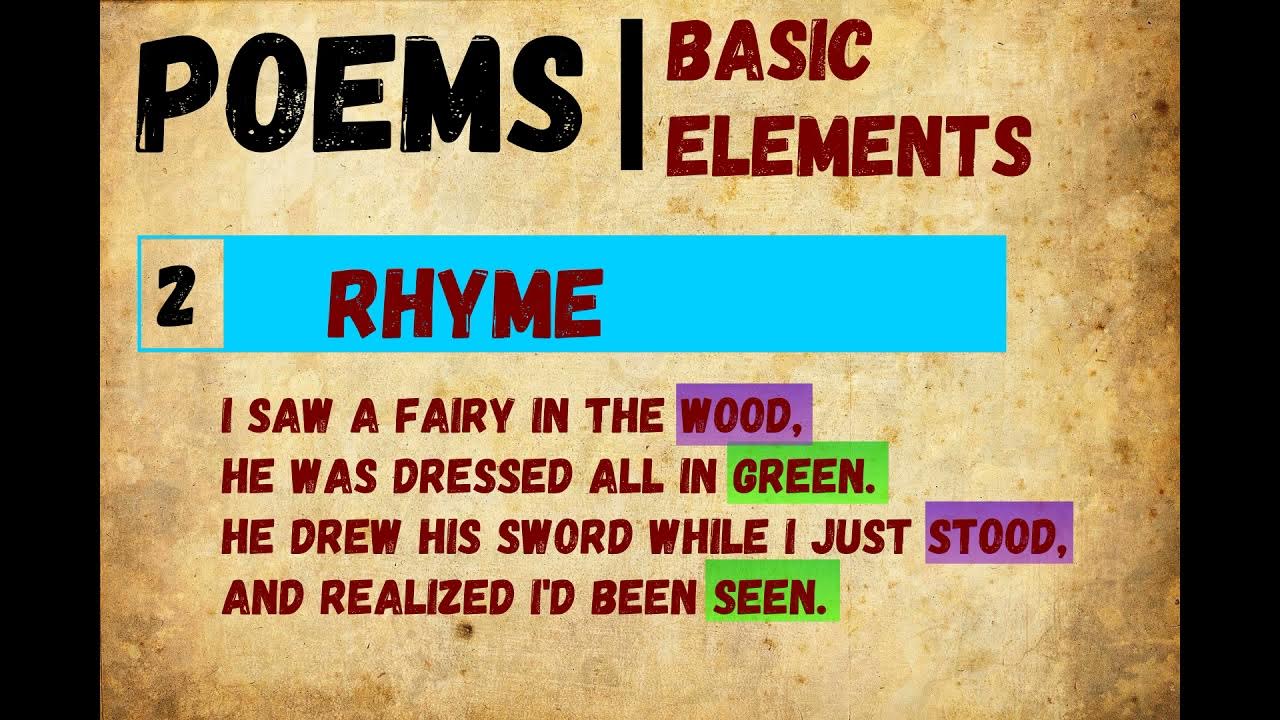Imaji/ citraan dalam Puisi. BAB Puisi Kelas X SMA/SMK
Summary
TLDRIn this educational video, the speaker delves into the concept of imagery (citraan) in poetry, explaining its role in enhancing the reader's sensory experience. Various types of imagery are discussed, including visual, auditory, tactile, emotional, gustatory, and olfactory imagery, each illustrated with clear examples. The speaker emphasizes how these sensory cues in poems make the content more immersive and relatable. Viewers are encouraged to participate by answering interactive questions in the comments. Overall, the video serves as an insightful guide to understanding and applying imagery in poetic expressions.
Takeaways
- 😀 Imagery (citraan) in poetry helps readers experience the poem through their senses, making it more vivid and engaging.
- 😀 There are six main types of imagery in poetry: visual, auditory, tactile, emotional, gustatory, and olfactory.
- 😀 Visual imagery engages the sense of sight and includes descriptions like colors, shapes, and scenes.
- 😀 Auditory imagery appeals to the sense of hearing, with examples such as sounds like rustling leaves or melodies.
- 😀 Tactile imagery involves the sense of touch, describing sensations like roughness, smoothness, or temperature.
- 😀 Emotional imagery evokes feelings such as sadness, happiness, or love, helping readers connect with the poem emotionally.
- 😀 Gustatory imagery pertains to taste and includes descriptions of flavors like sweet, bitter, or salty.
- 😀 Olfactory imagery deals with the sense of smell, using descriptions like fragrant or pungent to evoke scents.
- 😀 Poets use imagery to make their poems more impactful, allowing readers to feel as if they are experiencing the poem firsthand.
- 😀 The script encourages viewers to analyze example lines from poems and identify the type of imagery they contain.
- 😀 Engaging with imagery helps deepen understanding and appreciation for how poems create sensory experiences.
Q & A
What is the main purpose of imagery in poetry?
-The main purpose of imagery in poetry is to create vivid mental pictures that appeal to the senses, helping the reader or listener to experience the emotions and scenes described in the poem.
What are the different types of imagery mentioned in the video?
-The video discusses six types of imagery: visual, auditory, tactile, emotional, gustatory, and olfactory.
How is visual imagery used in poetry?
-Visual imagery, or imagery related to sight, allows the reader to visualize scenes, colors, and shapes described in the poem. Examples include descriptions like 'red,' 'green,' 'mountain,' or 'blooming flowers.'
What is auditory imagery in poetry?
-Auditory imagery refers to descriptions that appeal to the sense of hearing, such as sounds like 'the tinkling of water,' 'the rustling of leaves,' or 'a sweet melody.' It helps the reader hear the sounds as if they are part of the poem.
What is the role of tactile imagery in poetry?
-Tactile imagery involves descriptions that engage the sense of touch, such as 'rough,' 'soft,' 'cold,' or 'hot.' It allows the reader to feel the textures and sensations described in the poem.
How does emotional imagery function in a poem?
-Emotional imagery describes feelings and emotions, such as 'sadness,' 'joy,' 'love,' or 'grief.' It helps convey the emotional atmosphere and the internal experiences of characters or the speaker.
What is gustatory imagery?
-Gustatory imagery refers to descriptions of taste, helping the reader imagine flavors like 'bitter,' 'sweet,' 'sour,' or 'salty.' It engages the sense of taste and adds depth to the sensory experience in poetry.
What does olfactory imagery refer to?
-Olfactory imagery is related to smell. It allows the reader to imagine odors or fragrances, such as 'fresh flowers,' 'earthy scent,' or 'sharp perfume,' engaging the sense of smell.
Can you give an example of visual imagery from the video?
-One example of visual imagery mentioned in the video is 'Your beauty catches the heart like a rainbow in the evening sky,' where the image of a rainbow in the sky is used to evoke a visual impression.
What is the significance of using different types of imagery in a poem?
-Using different types of imagery helps to make a poem more engaging and vivid. It appeals to multiple senses, creating a more immersive and emotional experience for the reader or listener.
Outlines

This section is available to paid users only. Please upgrade to access this part.
Upgrade NowMindmap

This section is available to paid users only. Please upgrade to access this part.
Upgrade NowKeywords

This section is available to paid users only. Please upgrade to access this part.
Upgrade NowHighlights

This section is available to paid users only. Please upgrade to access this part.
Upgrade NowTranscripts

This section is available to paid users only. Please upgrade to access this part.
Upgrade NowBrowse More Related Video

POETRY | Descriptions & Imagery |ENGLISH 7 | MATATAG Curriculum VIDEO LESSON | QUARTER 1 | LESSON 1

Chapter 3 part 1

Literary Devices || ENGLISH 7 | Week 4 || QUARTER 1 || MATATAG CURRICULUM

BASIC ELEMENTS OF A POEM

Literatura Brasileira II EAD - Cruz e Sousa

MATERI PUISI LENGKAP KELAS 10 |BAHASA INDONESIA|
5.0 / 5 (0 votes)